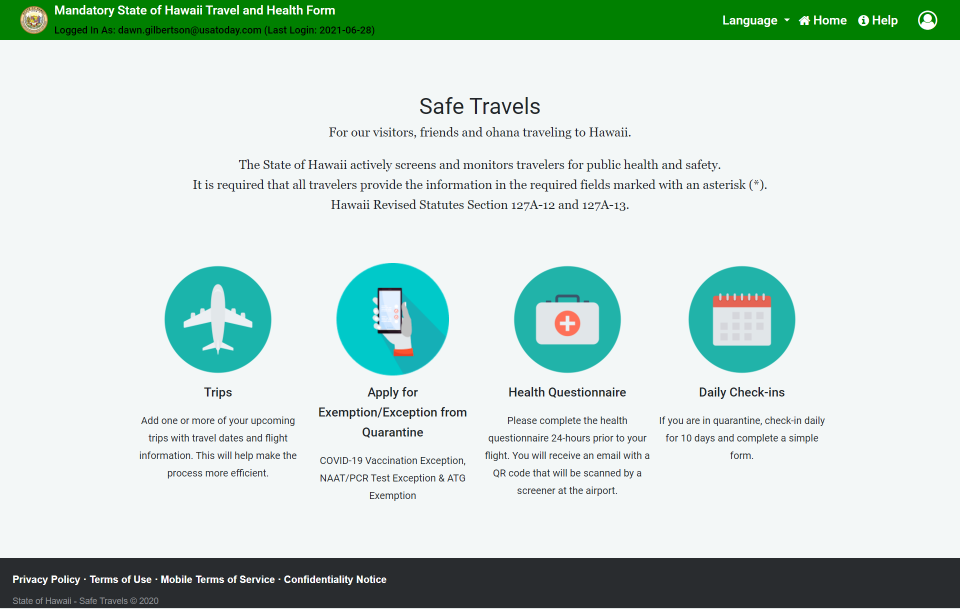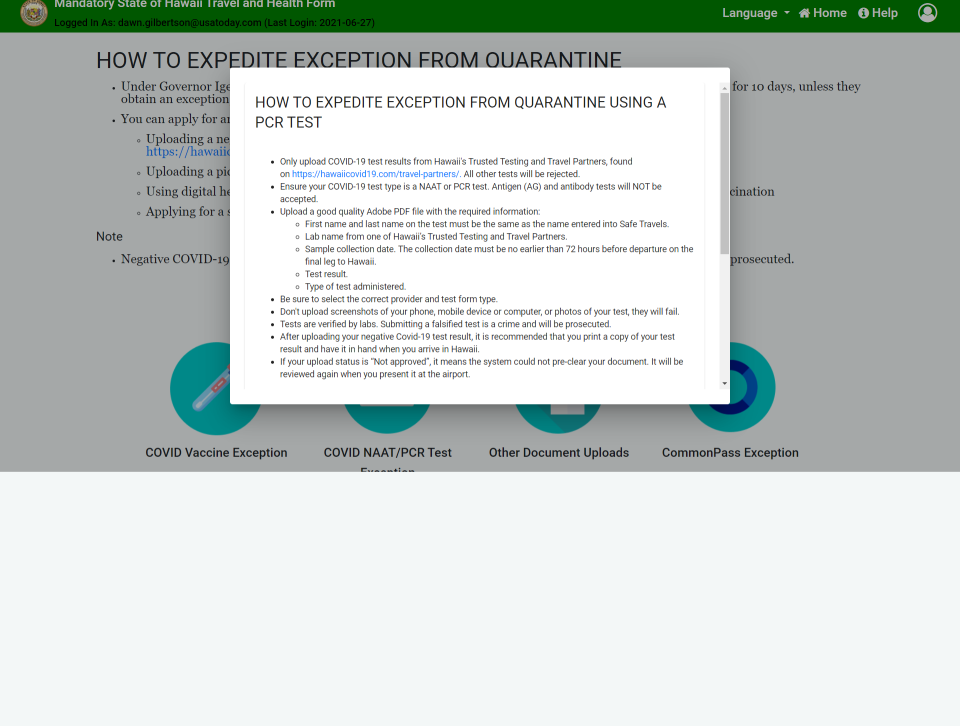Wrong COVID-19 tests, missing vaccine info and wristband envy: Don't make these Hawaii travel mistakes
Navigating Hawaii's extensive entry requirements before a late June trip should have been a cinch.
I've boarded more than two dozen flights during the pandemic, including a quick overnight trip to Honolulu last fall, and written countless stories about COVID-19 travel rules and restrictions.
Yet I still found myself slightly stressed when completing the many steps required to bypass the state's mandatory 10-day quarantine, the strictest in the country.
Take Hawaii's COVID-19 testing requirement. I was well aware I couldn't walk into the urgent care center I used for so many precautionary pre-travel tests because Hawaii only accepts certain tests from a lineup of trusted testing and travel partners. (The state began accepting vaccine proof as an alternative to testing a week after my trip.)
But I was still nervous about picking the right Walgreens or CVS – Hawaii's Safe Travels website underscored that only certain CVS locations qualify, for example – and scheduling the right test. (Hawaii requires a Nucleic Acid Amplification Test or PCR test.)
I checked and double-checked my math on when to test because Hawaii's rules say the test must be taken no more than 72 hours before your flight is scheduled to leave the mainland U.S., the results in hand before the final leg of any trip to Hawaii departs.
Scheduling a free self-swab appointment at a Walgreens drive-thru was relatively easy – I made mine for Saturday evening before a Tuesday morning nonstop flight to Maui from Phoenix – but not without a minor freakout when I read the fine print. "Test results turnaround time is based on when the sample arrives at the laboratory,'' it said. "Test results for travel purposes cannot be guaranteed in time for travel.'' (My negative results from the ID NOW rapid diagnostic test were emailed within a couple of hours.)
Uploading the test result to my Safe Travels account only caused minor anxiety: I wasn't sure whether to upload the "lab'' or "easy to read'' results Walgreens sent (I correctly guessed lab) and when I did, I initially uploaded a .png version instead of the required .pdf.
'We get cussed at every day': Maui tourist surge raises tensions, renews calls for visitor limits, new fees
Early-bird dining, beach reservations: 8 travel tips for maneuvering a visit to busy Maui, Hawaii
Traveling to Hawaii during the pandemic without quarantining: 'So. Many. Steps'
My 21-year-od son was flying to Hawaii with me and the list of instructions I sent him after I went through the process was longer than one of those to-do lists vacationers leave for the house sitter. My signoff: "So. Many. Steps.''
The trip went off without a hitch, but too often that's not the case for travelers headed to Hawaii as the pandemic continues and entry restrictions remain in place.
At a minimum, unprepared travelers face a last-minute scramble for tests and required documents or stress and delays at the airport. In the extreme, they are forced to cancel their trips last-minute, spend their vacation in strict quarantine, or turn around and fly home.
Troyden Tomooka has witnessed it all as a United Airlines employee in Maui. Late last year, a month into the Safe Travels program that effectively reopened Hawaii to tourists, he was so distraught about passengers arriving without a COVID-19 test or with a wrong or expired COVID-19 test he created a Facebook group to help travelers navigate the travel rules and restrictions.
"They saved up all their life to come to Hawaii only to be turned back,'' he said. "It became a heartbreak.''
The Maui Covid Travel Testing group has grown to include more than 10,000 members. Tomooka and a handful of moderators, including Alaska Airlines flight attendant Molly Flick, patiently and in great detail answer a flurry of questions from Hawaii-bound passengers every day. All are volunteers.
"It’s a lot to navigate,'' Flick said, especially for those who aren't tech whizzes. "I’m a savvy traveler but was overwhelmed and confused at first.''
They have created handy checklists for travelers headed to Hawaii, breaking out separate steps for vaccinated and unvaccinated passengers and a color-coded chart on when to test based on your day of departure.
This is all in addition to detailed information on the state of Hawaii's COVID-19 travel page and detailed reminders from airlines about the restrictions and requirements.
Still, nine months into the Safe Travels program, issues with documentation continue to crop up every day. Tomooka cited some recent examples: a traveler who was not eligible for the vaccine exemption because they hadn't been fully vaccinated for 15 days, the state's requirement, and those with the wrong COVID-19 tests or tests outside of the 72-hour window.
The requirements aren't likely to go away soon. Hawaii Gov. David Ige has said the Safe Travels program won't end until 70% of the state's residents are fully vaccinated; the figure just hit 60% last week, according to the Hawaii Department of Health. So travelers headed to Hawaii this summer or later this year need to brush up before travel.
Do's and don'ts for navigating Hawaii's COVID-19 travel restrictions
Do your homework long before your flight to Hawaii. Tomooka said he's surprised that some vacationers aren't aware of the complex steps they have to complete to bypass the state's strict 10-day quarantine. Join the private Facebook group he started for tips galore.

Don't wait until the last minute to upload your travel information. Packing for vacation is stressful enough without having to dig up flight and lodging information, vaccine card, your driver's license number or ID and other information required when setting up a Hawaii Safe Travels account. It can be set up as soon as your trip is booked, with information on COVID-19 test results, if necessary, added as the trip draws close. Don't forget to jot down the email and password you used to set up the account so it's easy to log back in and add the critical information, Tomooka said.
Do make sure you get the right COVID-19 test at the right time if you're unvaccinated. Hawaii has specific rules on testing, including requirements for children, and they continue to trip up travelers. Just because it's a reputable hospital or medical provider doesn't mean it's on Hawaii's trusted testing partners list. "People are still boggled about where to test,'' Tomooka said. The Facebook group he created has detailed information on the tests, as do airlines and the state of Hawaii. Upload the test results to your Safe Travels account when you receive them.

Don't pay too much (if anything) for a COVID-19 test. Walgreens is offering free drive-thru COVID-19 testing for those ages 3 and up at select locations in partnership with PNWHealth. The self-administered tests meet Hawaii's travel requirements. The eligible CVS tests, in contrast, cost $139 per person, and insurance is not accepted. Airport COVID-19 testing sites can run as high as $250 a person. See if your airline has testing partnerships or offers at-home testing. I paid a discounted $135 for a trip to Hawaii in November because Alaska Airlines had a partnership with the lab.
Do check your Centers for Disease Control and Prevention vaccine card to make sure it has the required information. The requirements include the traveler's name and date of birth (which must match the name on the traveler's Safe Travels account and photo ID); vaccine type; date(s) and lot numbers for each shot(s). If your card is missing information, request a duplicate from the provider or health officials. Leave plenty of time to get a new copy if needed. Upload the card to your Safe Travels account and bring the card with you.
Don't forget to fill out the required health questionnaire beginning 24 hours before the flight. Soon after checking in online for my Southwest flight, I received an alert from the state of Hawaii reminding me to fill out the state's travel health questionnaire. It asks four questions: Do you feel ill now; have you had a flu vaccine; have you taken medicine in the last 24 hours to bring down a fever; and have you signed a 10-day quarantine order that is currently in effect. You then have to attest that the information is true.
Do save that QR code. Travelers who have correctly completed all the steps in Hawaii's Safe Travels program before the flight will receive a QR code. Consider it your ticket to smooth(er) sailing upon landing in Hawaii. Save it on your phone and bring a hard copy for backup (ditto for test results and other key documents.)
Don't miss airlines' Hawaii prescreening option at the airport (and get in line early.) Southwest, United, Hawaiian, Alaska, American and other airlines have added passenger prescreening, usually called pre-clear, for Hawaii flights at select mainland airports. Southwest set up a counter near its Hawaii flight gates at Phoenix Sky Harbor International Airport. A representative asked to see my QR code and ID, verified the info in my Safe Travels account, and minutes later I was sporting a red wristband. Call it a Hawaii vacation fast pass. I flashed the wristband after landing at Kahului Airport in Maui and was able to skip screening there. (There were no screening lines when I landed but other passengers have reported screening lines upon arrival at peak times.)
This article originally appeared on USA TODAY: Hawaii travel restrictions: How to navigate COVID Safe Travels program

 Yahoo Movies
Yahoo Movies 
